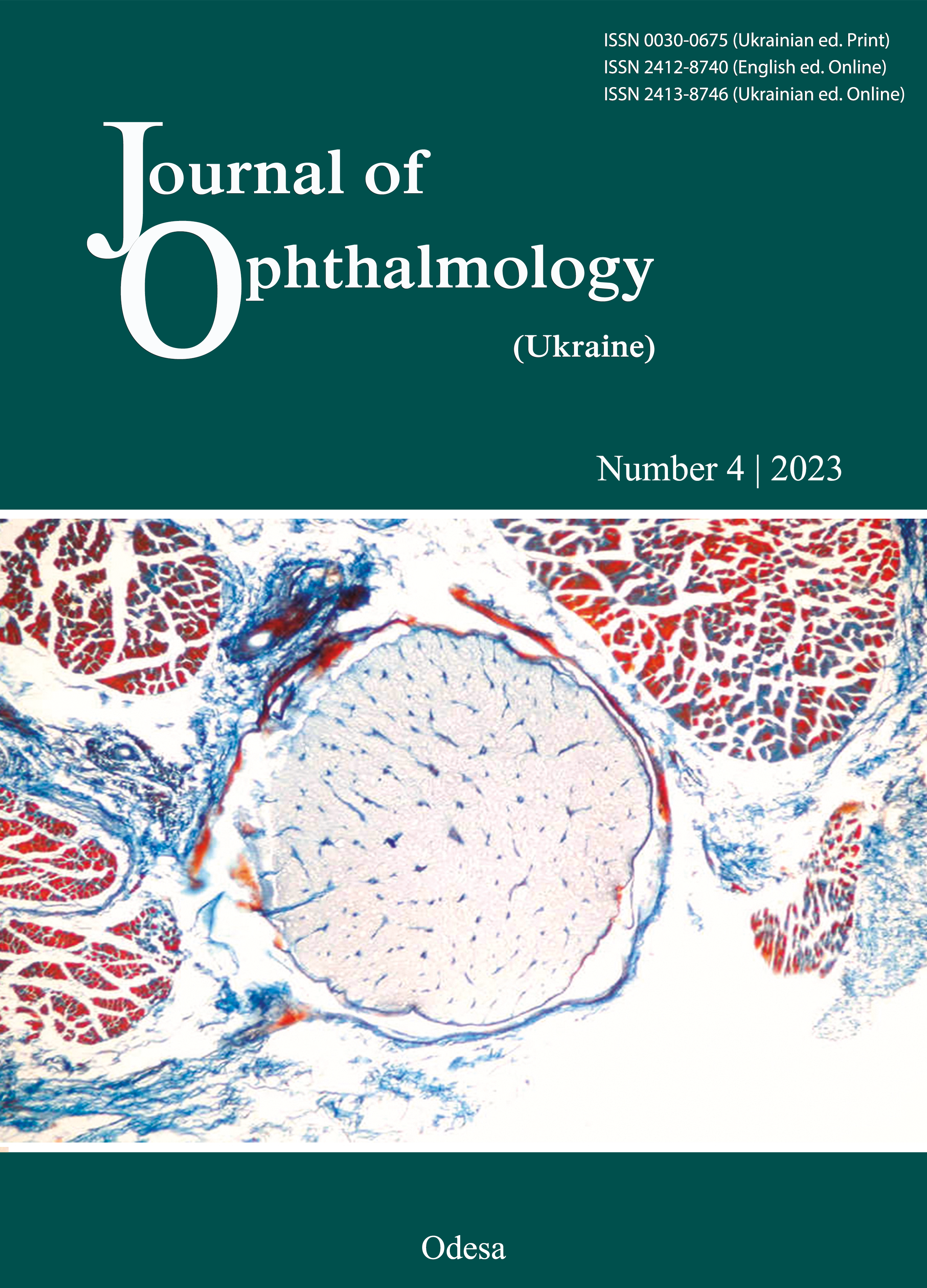Surgical treatment and survival of patients with invasive orbital tumors
DOI:
https://doi.org/10.31288/oftalmolzh202343440Keywords:
malignant craniofacial tumors, orbital invasion, transbasal approach, subcranial approach, orbital exenterationAbstract
Background: Intraorbital tumor invasion is not uncommon among craniofacial tumors, and is seen in 27% of cases. Craniofacial malignancies account for 3% of all head and neck tumors. Malignant tumors are more common than benign and comprise about 73% of all craniofacial tumors with intraorbital invasion. Their growth is aggressive and invasive, leading to early postoperative recurrence. The survival of patients with malignant craniofacial tumors depends largely on orbital invasion, and patients demonstrating orbital invasion had a 40% survival rate, while patients without had a survival rate of 72%. Patients with total resection of craniofacial tumors (including those with intraorbital extensions) show higher non-recurrence and survival rates than patients without total resection. Orbital exenteration does not provide patients with better survival rates and worsened the quality of life.
Purpose: To assess the outcomes of surgical treatment for, and the survival of patients with, malignant craniofacial tumors growing into the orbit.
Material and Methods: We reviewed the outcomes of surgical treatment for, and the survival of 94 patients with, malignant craniofacial tumors growing into the orbit.
Results: Destruction of the bony orbital wall only (without periorbital adhesion), was seen in 27/94 cases (28.7%), whereas periorbital invasion, in 67/94 cases (71.3%). The tumor was excised completely with visually clear margins in all cases. Patient survival was affected by the degree of orbital invasion. The recurrence rate after surgery for malignant craniofacial tumors growing into the orbit was 44.7% (40/94 patients). Ten patients had a local intraorbital recurrence after surgery for malignant craniofacial tumors growing into the orbit.
Conclusion: Periorbital invasion was seen in 71.3% of patients with malignant craniofacial tumors. There was no significant difference in the survival of patients with malignant craniofacial tumors of different histology. Orbital exenteration does not improve survival and recurrence in patients with malignant craniofacial tumors with orbital invasion. In patients with preoperative periorbital invasion and further intraorbital extension, the recurrence rate was more than three-fold higher than in those showing only destruction of the bony orbital wall preoperatively.
References
Varshney S, Bist SS, Gupta N, Singh RK, Bhagat S. Anterior craniofacial resection - for paranasal sinus tumors involving anterior skull base. Indian J Otolaryngol Head Neck Surg. 2010 Jun;62(2):103-7. https://doi.org/10.1007/s12070-010-0045-1
Blacklock JB, Weber RS, Lee YY, Goepfert H. Transcranial resection of tumors of the paranasal sinuses and nasal cavity. J Neurosurg. 1989 Jul;71(1):10-5. https://doi.org/10.3171/jns.1989.71.1.0010
Shah JP, Kraus DH, Bilsky MH, Gutin PH, Harrison LH, Strong EW. Craniofacial resection for malignant tumors involving the anterior skull base. Arch Otolaryngol Head Neck Surg. 1997 Dec;123(12):1312-7. https://doi.org/10.1001/archotol.1997.01900120062010
Castelnuovo P, Lambertoni A, Sileo G, Valentini M, Karligkiotis A, Battaglia P, Turri-Zanoni M. Critical review of multidisciplinary approaches for managing sinonasal tumors with orbital involvement. Acta Otorhinolaryngol Ital. 2021 Apr;41(Suppl. 1):S76-S89. https://doi.org/10.14639/0392-100X-suppl.1-41-2021-08
McCutcheon IE, Blacklock JB, Weber RS, DeMonte F, Moser RP, Byers M, Goepfert H. Anterior transcranial (craniofacial) resection of tumors of the paranasal sinuses: surgical technique and results. Neurosurgery. 1996 Mar;38(3):471-9; discussion 479-80. https://doi.org/10.1227/00006123-199603000-00009
Blau, T. H. Quality of life, social indicators, and criteria of change. Professional Psychology. 1977, 464-73. https://doi.org/10.1037/0735-7028.8.4.464
Abuzayed B, Canbaz B, Sanus GZ, Aydin S, Cansiz H. Combined craniofacial resection of anterior skull base tumors: long-term results and experience of single institution. Neurosurg Rev. 2011 Jan;34(1):101-13. https://doi.org/10.1007/s10143-010-0286-1
Ladziński P, Majchrzak H, Kaspera W, Maliszewski M, Majchrzak K, Tymowski M, Adamczyk P. Direct and remote outcome after treatment of tumours involving the central skull base with the extended subfrontal approach. Neurol Neurochir Pol. 2009 Jan-Feb;43(1):22-35.
Chu Y, Liu HG, Yu ZK. Patterns and incidence of sinonasal malignancy with orbital invasion. Chin Med J (Engl). 2012 May;125(9):1638-42.
Emery E, Alaywan M, Sindou M. Respective indications of orbital and/or zygomatic arch removal combined with fronto-pteriono-temporal approaches. 58 cases. Neurochirurgie. 1994;40(6):337-47. French.
Cherekaev VA, Golbin DA, Gasparyan TG, Shishkina LV, Tsukanova TV. Management of craniofacial chondroid tumors. J Craniofac Surg. 2015 Jan;26(1):10-8. https://doi.org/10.1097/SCS.0000000000001307
Jethanamest D, Morris LG, Sikora AG, Kutler DI. Esthesioneuroblastoma: a population-based analysis of survival and prognostic factors. Arch Otolaryngol Head Neck Surg. 2007 Mar;133(3):276-80. https://doi.org/10.1001/archotol.133.3.276
Goel A. Anterior transcranial (craniofacial) resection of tumors of the paranasal sinuses: surgical technique and results. Neurosurgery. 1997 Jan;40(1):218-9; 219-20. https://doi.org/10.1097/00006123-199701000-00055
Gil Z, Patel SG, Cantu G, Fliss DM, Kowalski LP, et al. International Collaborative Study Group; Bridger PG, Cheesman AD, Donald P, Gullane P, Janecka I, Kamata SE, Levine PA, Medina LR, Pradhan S, Schramm V, Wei WI. Outcome of craniofacial surgery in children and adolescents with malignant tumors involving the skull base: an international collaborative study. Head Neck. 2009 Mar;31(3):308-17. https://doi.org/10.1002/hed.20958
Higgins TS, Thorp B, Rawlings BA, Han JK. Outcome results of endoscopic vs craniofacial resection of sinonasal malignancies: a systematic review and pooled -data analysis. Int Forum Allergy Rhinol. 2011 Jul-Aug;1(4):255-61. https://doi.org/10.1002/alr.20051
Dias FL, Sá GM, Kligerman J, Nogueira J, Galvão ML, Lima RA. Prognostic factors and outcome incraniofacial surgery for malignant cutaneous tumors involving the anterior skull base. Arch Otolaryngol Head Neck Surg. 1997 Jul;123(7):738-42. https://doi.org/10.1001/archotol.1997.01900070082013
Eisen MD, Yousem DM, Loevner LA, Thaler ER, Bilker WB, Goldberg AN. Preoperative imaging to predict orbital invasion by tumor. Head Neck. 2000 Aug;22(5):456-62. https://doi.org/10.1002/1097-0347(200008)22:5<456::AID-HED3>3.0.CO;2-N
Haerle SK, Gullane PJ, Witterick IJ, Zweifel C, Gentili F. Sinonasal carcinomas: epidemiology, pathology, and management. Neurosurg Clin N Am. 2013 Jan;24(1):39-49. https://doi.org/10.1016/j.nec.2012.08.004
Raso JL, Gusmão S. Transbasal approach to skull base tumors: evaluation and proposal of classification. Surg Neurol. 2006;65 Suppl1:S1:33-1:38. https://doi.org/10.1016/j.surneu.2005.11.037
Terz JJ, Alksne JF, Lawrence W Jr. Craniofacial resection for tumors invading the pterygoid fossa. Am J Surg. 1969 Nov;118(5):732-40. https://doi.org/10.1016/0002-9610(69)90220-7
Yafit D, Duek I, Abu-Ghanem S, Ungar OJ, Wengier A, Moshe-Levyn H, etal. Surgical approaches for infratemporal fossa tumor resection: Fifteen years' experience of a single center. Head Neck. 2019 Nov;41(11):3755-63. https://doi.org/10.1002/hed.25906
Komotar RJ, Starke RM, Raper DM, Anand VK, Schwartz TH. Endoscopic endonasal compared with anterior craniofacial and combined cranionasal resection of esthesioneuroblastomas. World Neurosurg. 2013 Jul-Aug;80(1-2):148-59. https://doi.org/10.1016/j.wneu.2012.12.003
Krischek B, Carvalho FG, Godoy BL, Kiehl R, Zadeh G, Gentili F. From craniofacial resection to endonasal endoscopic removal of malignant tumors of the anterior skull base. World Neurosurg. 2014 Dec;82(6 Suppl):S59-65. https://doi.org/10.1016/j.wneu.2014.07.026
Roxbury CR, Ishii M, Richmon JD, Blitz AM, Reh DD, Gallia GL. Endonasal Endoscopic Surgery in the Management of Sinonasal and Anterior Skull Base Malignancies. Head Neck Pathol. 2016 Mar;10(1):13-22. https://doi.org/10.1007/s12105-016-0687-8
Xie M, Yu J, Li L, Jia R, Song X, Wang Y, Fan X. Nomogram for Preoperative Estimation of Orbit Invasion Risk in Periocular Squamous Cell Carcinoma. Front Oncol. 2020 Apr 30;10:564. https://doi.org/10.3389/fonc.2020.00564
Cantù G, Riccio S, Bimbi G, Squadrelli M, Colombo S, Compan A, Rossi M, Pompilio M, Solero CL. Craniofacial resection for malignant tumours involving the anterior skull base. Eur Arch Otorhinolaryngol. 2006 Jul;263(7):647-52. https://doi.org/10.1007/s00405-006-0032-z
Sugawara T, Aoyagi M, Ogishima T, Kawano Y, Tamaki M, Yano T, Tsunoda A, Ohno K, Maehara T, Kishimoto S. Extended orbital exenteration for sinonasal malignancy with orbital apex extension: surgical technique and clinical analysis. J Neurosurg. 2015 Jul;123(1):52-8. https://doi.org/10.3171/2014.9.JNS141256
Patel SG, Singh B, Polluri A, Bridger PG, Cantu G, Cheesman AD, et al. Craniofacial surgery for malignant skull base tumors: report of an international collaborative study. Cancer. 2003 Sep 15;98(6):1179-87. https://doi.org/10.1002/cncr.11630
Andersen PE, Kraus DH, Arbit E, Shah JP. Management of the orbit during anterior fossa craniofacial resection. Arch Otolaryngol Head Neck Surg. 1996 Dec;122(12):1305-7. https://doi.org/10.1001/archotol.1996.01890240013004
Albu S, StFlorian I, Szabo I, Băciuţ G, Băciuţ M, Mitre I. Craniofacial resection for malignant tumors of the paranasal sinuses. Chirurgia (Bucur). 2011 Mar-Apr;106(2):219-25.
Dulguerov P, Allal AS. Nasal and paranasal sinus carcinoma: how can we continue to make progress? Curr Opin Otolaryngol Head Neck Surg. 2006 Apr;14(2):67-72.
Downloads
Published
How to Cite
Issue
Section
License
Copyright (c) 2023 О. І. Паламар, А. П. Гук, Богдан Олегович Давиденко , Д. І. Оконський, О. С. Усатов

This work is licensed under a Creative Commons Attribution 4.0 International License.
This work is licensed under a Creative Commons Attribution 4.0 International (CC BY 4.0) that allows users to read, download, copy, distribute, print, search, or link to the full texts of the articles, or use them for any other lawful purpose, without asking prior permission from the publisher or the author as long as they cite the source.
COPYRIGHT NOTICE
Authors who publish in this journal agree to the following terms:
- Authors hold copyright immediately after publication of their works and retain publishing rights without any restrictions.
- The copyright commencement date complies the publication date of the issue, where the article is included in.
DEPOSIT POLICY
- Authors are permitted and encouraged to post their work online (e.g., in institutional repositories or on their website) during the editorial process, as it can lead to productive exchanges, as well as earlier and greater citation of published work.
- Authors are able to enter into separate, additional contractual arrangements for the non-exclusive distribution of the journal's published version of the work with an acknowledgement of its initial publication in this journal.
- Post-print (post-refereeing manuscript version) and publisher's PDF-version self-archiving is allowed.
- Archiving the pre-print (pre-refereeing manuscript version) not allowed.












